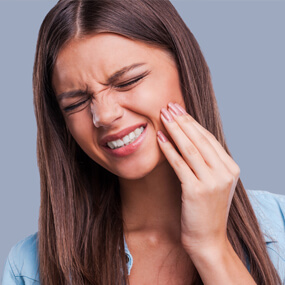10 Warning Signs That You Need to See a Dentist ASAP

Preventive dental care is the best way to ensure that your teeth and gums are healthy throughout your life. That starts at home with regular brushing and flossing, but most dental professionals recommend visiting a dentist twice a year for a cleaning and regular checkup as a proactive measure.
Life is often busy, and a regular checkup can seem like a hassle. But people who have their teeth cleaned and examined biannually are much less prone not only to tooth decay and gum disease but serious health conditions like cardiovascular disease, diabetes, and dementia. Another reason to see your dentist preemptively is that tooth decay and gum disease often do not manifest symptoms in the early stages.
As gum disease and tooth decay progress, however, various symptoms will reveal themselves. Let’s have a look at 10 symptoms that should have you calling your dentist for a visit as soon as possible.
- Toothache – A toothache is a telltale sign that you need to see a dentist posthaste. Your teeth should never ache, and it is an indication that something is wrong. While the underlying issue can be relatively minor, it can also be quite serious, and that may be more likely if you have not been regularly seeing a dentist.
- Sensitive Teeth – Some people’s teeth are more sensitive than others. If you experience minor or infrequent sensitivity, you should discuss it with your dentist during your next regular checkup. However, if it has come on recently, is intense, or is frequently occurring, it may indicate that your enamel is eroding. Beneath your enamel is dentin, which is sensitive to hot, cold, sweet, sour, and so forth.
- Persistent Bad Breath – Bad breath happens to the best of us from time to time and is more common among people who smoke, drink, and eat certain foods. Persistent bad breath, especially after performing proper oral hygiene, is an indication that you have gum disease or another serious oral health complication.
- Gums That Bleed Easily – Bleeding when you brush your teeth, floss, or chew food is not normal. When it occurs while brushing, it could be an indication that you are brushing too hard or your bristles are too stiff. When flossing, it could mean you are using improper technique and damaging your gums. However, it is also one of the more common symptoms of periodontal disease, which can get quite serious if left untreated.
- Dry Mouth – Everyone gets dry mouth from time to time and often from not drinking enough water. If you experience a dry mouth frequently, however, it can be an indication of xerostomia. If xerostomia is not treated, you do not produce enough saliva and are thus more prone to gum disease and tooth decay.
- White Spots on Your Teeth – Cavities can be difficult to spot with the naked eye early on. White spots on the teeth are usually the first visual indication that you have tooth decay. These white spots are caused by acids eating through the enamel. Left untreated, the decay will reach your dentin and become much more serious.
- Gum recession – Some gum recession is natural as we age. But receding gums is also among the more serious symptoms of gum disease. That lost tissue cannot be regenerated. It exposes the tooth roots to decay, and it creates periodontal pockets that accumulate plaque and tartar and can get infected.
- Loose or Shifted Teeth – Your permanent teeth should last your entire life. If you notice that a tooth or multiple teeth move slightly or have shifted, this can indicate infection, bone loss, and other oral health issues. Not treated, those teeth will continue to loosen and will eventually fall out. You should also monitor any changes to your bite and discuss with your dentist.
- Sores, Lumps, and Lesions – Canker sores generally go away on their own, but if you frequently experience them, you may want to discuss your options with your dentist. Other lesions, as well as bumps and lumps, should not be ignored, and white spots on the tongue, tonsils, inner cheek, and mouth roof can indicate a fungal infection known as thrush.
- Frequent Morning Headaches – Do you often experience headaches in the morning? While you may not associate headaches with dental care, frequent morning headaches are often an indication of nocturnal bruxism. While you sleep, you may be excessively clenching your jaw and grinding your teeth, which is what causes the headaches.
How to Keep Your Mouth Healthy
There are often no symptoms related to early gum disease and tooth decay. This is why it so important to see your dentist regularly and to practice good oral hygiene every day. You should:
- Brush twice a day for two to three minutes.
- Use fluoride toothpaste and a soft-bristled brush.
- Brush or scrape your tongue whenever you brush your teeth.
- Floss whenever you brush as well.
- Discuss dental sealants and fluoride rinses with your dentist.
- Keep dentures clean and remove them overnight to avoid gum irritation.
Protect Your Health Through Regular Dental Visits
If you are experiencing any of the signs discussed above, Jeffrey D. Clark, DDS, strongly urges you to schedule an appointment as soon as possible. You should also visit your dentist on a regular basis to have your teeth cleaned and to receive preventive care. The oral hygienists at Scottsdale Cosmetic Dentistry Excellence can clean your teeth, and Dr. Clark can examine them and advise any necessary treatments. Call us at 480 585 1853 with any questions and to schedule your appointment.




